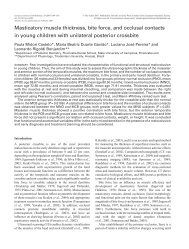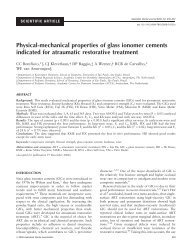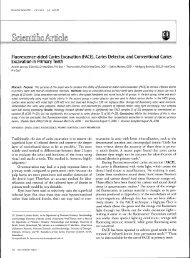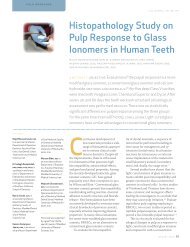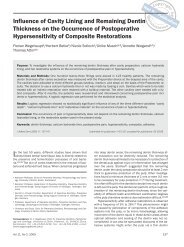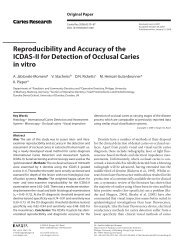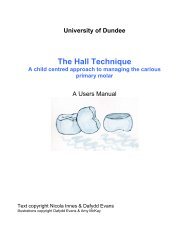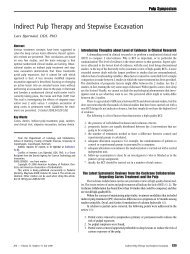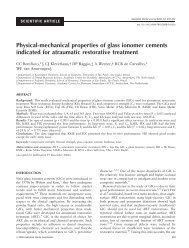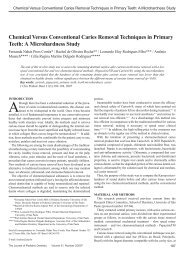Pit and Fissure Sealants in the Prevention of Dental Caries in ...
Pit and Fissure Sealants in the Prevention of Dental Caries in ...
Pit and Fissure Sealants in the Prevention of Dental Caries in ...
You also want an ePaper? Increase the reach of your titles
YUMPU automatically turns print PDFs into web optimized ePapers that Google loves.
––– <strong>Sealants</strong>: <strong>Prevention</strong> <strong>of</strong> <strong>Caries</strong> –––<br />
Appendix 3 Efficacy <strong>of</strong> pit <strong>and</strong> fissure sealants: techniques <strong>and</strong> materials used<br />
Citation: Feigal RJ, Musherure P, Gillespie B, Levy-Polack M, Quelhas I, Hebl<strong>in</strong>g J. Improved sealant retention with<br />
bond<strong>in</strong>g agents: a cl<strong>in</strong>ical study <strong>of</strong> two-bottle <strong>and</strong> s<strong>in</strong>gle-bottle systems. J Dent Res 2000; 79(11):1850–6.<br />
Material: Fluoroshield sealant (Dentsply/Caulk, Milford, Del.)<br />
Various bond<strong>in</strong>g agents before sealant placement:<br />
• Tenure primer (Den-Mat, Santa Maria, Calif.)<br />
• Scotchbond Multipurpose primer (3M <strong>Dental</strong> Products Division, St. Paul, M<strong>in</strong>n.)<br />
• Both <strong>of</strong> <strong>the</strong> preced<strong>in</strong>g are components <strong>of</strong> fourth-generation (2-bottle) dent<strong>in</strong>-bond<strong>in</strong>g systems that have <strong>in</strong>dividual<br />
component bottles for <strong>the</strong> primer <strong>and</strong> <strong>the</strong> adhesive portion <strong>of</strong> <strong>the</strong> bond<strong>in</strong>g agent<br />
• Prime & Bond (Dentsply/Caulk), <strong>the</strong> newer fifth-generation (one-bottle) dent<strong>in</strong>-bond<strong>in</strong>g system<br />
Selection <strong>of</strong> Teeth <strong>and</strong> Tooth Type or Morphology: Newly erupted permanent first molars<br />
Technique:<br />
1. Slow-speed dry-brush clean<strong>in</strong>g <strong>of</strong> <strong>the</strong> surface<br />
2. Cotton roll isolation<br />
3. 30 seconds phosphoric acid gel etch<strong>in</strong>g<br />
4. 15 seconds r<strong>in</strong>se <strong>and</strong> air-dry<br />
5. Placement <strong>of</strong> bond<strong>in</strong>g agent with a h<strong>and</strong>-held brush, air-th<strong>in</strong>ned across <strong>the</strong> surface<br />
6. Application <strong>of</strong> sealant<br />
7. 40 seconds light-cur<strong>in</strong>g <strong>of</strong> sealant <strong>and</strong> bond<strong>in</strong>g agent toge<strong>the</strong>r<br />
Citation: Yazici AR, Kiremitci A, Celik C, Ozgunaltay G, Dayangac B. A two-year cl<strong>in</strong>ical evaluation <strong>of</strong> pit <strong>and</strong> fissure<br />
sealants placed with <strong>and</strong> without air abrasion pretreatment <strong>in</strong> teenagers. J Am Dent Assoc 2006; 137(10):1401–5.<br />
Material: Concise Light Cure White Sealant (3M ESPE, St. Paul, M<strong>in</strong>n.), an unfilled sealant, with a filler weight<br />
<strong>of</strong> 9.9%<br />
Selection <strong>of</strong> Teeth <strong>and</strong> Tooth Type or Morphology: Maxillary <strong>and</strong> m<strong>and</strong>ibular permanent premolars <strong>and</strong> molars<br />
Technique:<br />
1. Clean tooth with pumice <strong>and</strong> water slurry us<strong>in</strong>g a slow-speed h<strong>and</strong>piece for 30 seconds.<br />
2. Wash <strong>the</strong> tooth with a water spray for 60 seconds.<br />
3. For group I, etch occlusal fissures with 35% phosphoric acid gel for 30 seconds us<strong>in</strong>g a microbrush.<br />
4. R<strong>in</strong>se enamel with water for 30 seconds, <strong>the</strong>n dry enamel for 15 seconds with oil-free compressed air.<br />
5. For group II, abrade occlusal fissures with an air abrasion device (PrepStart, Danville Materials, San Ramon, Calif.)<br />
with 27-µm alum<strong>in</strong>um oxide particles at pressure <strong>of</strong> 120 pounds per square <strong>in</strong>ch (nozzle tip perpendicular to <strong>the</strong> surface,<br />
at a distance <strong>of</strong> 2–3 mm).<br />
6. R<strong>in</strong>se teeth with a water spray for 30 seconds to clean residual alum<strong>in</strong>um particles from <strong>the</strong> surface.<br />
7. Etch prepared occlusal fissures with 35% phosphoric acid gel for 30 seconds.<br />
8. Thoroughly r<strong>in</strong>se <strong>and</strong> dry (similar to group I).<br />
9. Apply Concise Light Cure White Sealant to prepared surfaces us<strong>in</strong>g a microbrush <strong>and</strong> an explorer.<br />
10. Apply 40 seconds <strong>of</strong> light-cur<strong>in</strong>g with a power output <strong>of</strong> 400 mW/cm 2 .<br />
11. Remove rubber dam, check occlusion, adjust sealants with a composite f<strong>in</strong>ish<strong>in</strong>g bur, <strong>and</strong> polish sealants with polish<strong>in</strong>g<br />
po<strong>in</strong>ts.<br />
JCDA • www.cda-adc.ca/jcda • March 2008, Vol. 74, No. 2 • App_183xxvii





